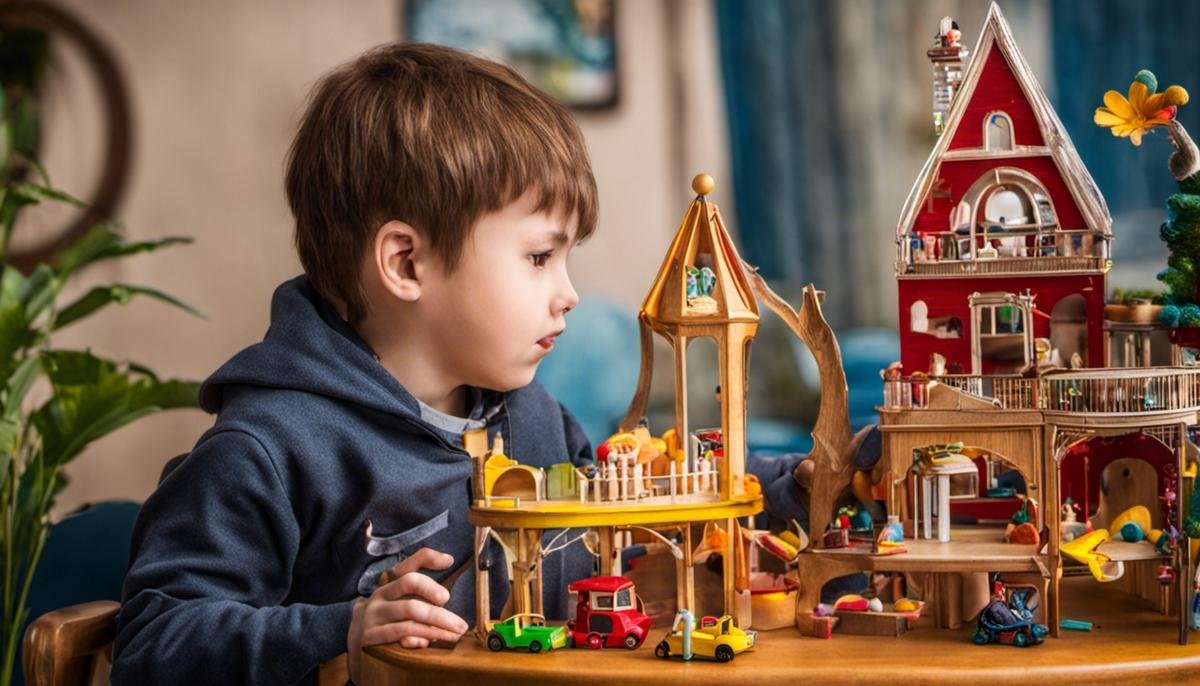
In this increasingly diverse world, understanding and appreciating the distinct aspects of all individuals is crucial for creating an inclusive society. One such unique group consists of those diagnosed with Autism Spectrum Disorder (ASD), an intricately layered neurological disorder that manifests differently in each affected person. This complexity often leads to misconceptions and misunderstandings about ASD, particularly in the area of sensory processing. This discussion is designed to thread the needle through these intricacies, bringing to light the realities of ASD and sensory processing issues, how they intertwine, and their impact on daily life. Furthermore, this discourse illuminates ways we can support individuals affected by ASD and their families, thus fostering a community of acceptance and understanding.
1. What is Autism Spectrum Disorder (ASD)?
Understanding Autism Spectrum Disorder (ASD): A Closer Look Into a Complex Condition
Autism Spectrum Disorder (ASD). You’ve probably come across this term in numerous spaces, ranging from your child’s school, on the internet or in medical offices. It’s a term that’s becoming more universally recognized, however, it can still feel mysterious and somewhat frightening, especially for parents. The goal here is to shed a little more light on this broad diagnosis, to understand it better, and to make it a bit more relatable for everyone.
In its simplest form, ASD is a neurological condition. But it’s not just any neurological condition. Consider this spectrum as a rainbow, with varying shades of colors representing the wide range of symptoms and severity that individuals diagnosed with ASD can have. These can range from social communication difficulties to stereotyped repetitive behaviors.
People with ASD often see, hear and feel the world in a unique way. They might find social situations overwhelming; they might appreciate following routines and could get disturbed when these routines change. They may struggle with communication or, alternatively, they may have impressive language skills. The reality is, no two individuals with autism are the same, and this breadth of experiences and ways of processing the world is represented in the term ‘spectrum’.
In many cases, signs of autism begin to appear in early childhood, usually by the age of 2 or 3. Developmental delays or difficulties can often be a tell-tale sign of ASD. However, some people go undiagnosed until adulthood. With all these variables, what’s the takeaway? ASD is a complex condition, and quite honestly, there are still many unanswered questions.
But here’s some good news. Today, more than ever before, researchers are dedicating time and resources to studying ASD. Schools are becoming more accommodating, and children with ASD have access to more resources to help them thrive. Parents and caregivers are being given more tools and educational materials to enhance their understanding on how to nurture and support individuals with ASD.
If you suspect your child may fall onto the spectrum, it’s crucial to seek the advice of medical professionals, who can perform comprehensive evaluations. Early detection can make a significant difference in helping your child receive the right interventions and support. Resources like Autism Speaks can be a helpful place to start your learning journey.
Autism Spectrum Disorder is far from a one-size-fits-all condition. It’s an immensely broad term, encompassing a rainbow of experiences and symptoms, and touching countless families worldwide. Remember that if your child, or if anyone you know, is diagnosed with ASD, they’re not alone. There’s a supportive community all around, full of resources, anecdotes, and advice to navigate these unique challenges with courage and optimism. Together, we can understand and embrace the unique colors of this spectrum. The key is to keep asking, keep learning, and above all, keep loving.

2. What are Sensory Processing Issues?
Decoding Sensory Processing Issues within the Autism Spectrum
There’s a hidden layer to autism awareness that often goes unnoticed; it’s called sensory processing issues. If think of the five senses – sight, hearing, taste, touch, smell – we all perceive sensations in somewhat similar ways. But for some individuals, particularly those with Autism Spectrum Disorder (ASD), these sensations can be experienced quite differently. Their unique way of processing information from the senses or environment around them can often lead to sensory processing issues.
Sensory processing issues aren’t a distinct medical diagnosis. They’re typically identified as a symptom or characteristic of ASD, and they affect how an individual interacts with the world around them. Some individuals may be hypersensitive or oversensitive – they might feel overwhelmed by crowded spaces, or find certain sounds or textures uncomfortable. Others may be hyposensitive – they might not feel pain or extreme temperatures, or they may need a higher level of stimuli to engage.
There’s a broad scope of influence that sensory processing issues can have. It’s not limited merely to their physical perceptions; it alters how they see, touch, feel, and understand their surroundings and interactions within it. For our little ones with ASD, it might mean they find simple tasks like brushing teeth or getting dressed challenging, due to the overwhelming sensations they encounter.
Fostering a better understanding of sensory processing issues is the first step to supporting those affected. This requires us to keenly observe our loved ones and identify what may trigger a sensory overload or underload, helping them create coping strategies and develop a comfortable, safe environment.
Therapists and professionals specialized in sensory integration can work hand in hand as you journey with your family member through this process. Therapies such as Occupational Therapies (OT) help develop strategies to navigate day-to-day tasks, while Sensory Integration Therapy (SIT) helps individuals develop responses to sensory stimuli.
Likewise, practical tools like sensory toys, headphones for sound sensitivity, and stress balls, can help manage their sensory processing problems, making everyday actions and environments more tolerable and engaging.
Remember, every individual’s experience with ASD and sensory processing issues is unique. Celebrate their differences and champion their victories, however small they may seem to the wider world.
Seeking help, educating ourselves, and embracing their unique perspective of the world are all about building the love, support, and understanding that’s needed to navigate the complexities of ASD. After all, doesn’t every member of our family deserve to experience the world in a way that makes sense to them? However unique it may be. And we can all contribute: offer support, foster understanding, and create a world that is accepting and aware.

3. Sensory Processing Issues in Autistic Individuals
Understanding Sensory Processing Issues in Autism: A Closer Look
Autism Spectrum Disorder (ASD) is a complex neurological condition that affects how individuals interact with the world around them. One of the many nuances in individuals with ASD is their experience with sensory processing, which often manifests differently compared to neurotypical individuals. Providing a compassionate, comprehensive understanding of these sensory processing differences is pivotal to supporting and advocating for those within the spectrum.
Sensory processing refers to how our brain receives and responds to information that it gets from our senses. For those within the autism spectrum, these processes can become muddled, leading to what is commonly classified as sensory processing issues or sensory processing disorder. They experience sensory information differently, sometimes even overwhelmingly.
Individuals within the spectrum may either have hypersensitivity (over-responsiveness) to sensory input or hyposensitivity (under-responsiveness). Their reactions to sensory stimuli vary widely, from adoring a specific texture or sound to getting excessively distressed by the same.
It’s important to note that sensory issues in autism are not an indicator of pickiness or rigidness, but a reflection of an individual’s neurological setup. Everyday tasks can become challenging due to these issues – for instance, the texture of a specific fruit might be unbearable, or the sound of a vacuum cleaner might trigger an overwhelming reaction. Hence, an understanding environment is essential to help children navigate through these challenges.
Professional therapists trained in sensory integration can be a tremendous help. These professionals use specific strategies and therapies to help manage sensory processing issues. This might include special exercises to help children modulate their sensory responses.
One proven strategy is providing controlled sensory experiences, which can safely expose them to a variety of stimuli, thus helping them to adjust. Additionally, simple tools – ranging from weighted blankets for calming pressure to noise-reducing headphones for blocking overwhelming sounds – can make everyday life more navigable for children with sensory issues.
We are all unique in our ways, and acknowledging individual differences should be the norm rather than the exception. Just like we celebrate our hobbies and passions, we should validate and respect sensory preferences of individuals within the autism spectrum.
In every step of this journey, building love, support, and understanding is crucial. This not only assists individuals with ASD handle their own sensorial world but also emphasizes the positive elements of neurodiversity. The strategy is clear: promote awareness, provide support, and create an accepting environment.
Let it be a call to action for us all: offer support to those navigating sensory processing issues, foster empathy in our homes, schools, and communities, and indeed, create a world that values and appreciates all forms of neurological diversity. Remember, change starts at home – so, let us learn and grow together in building this supportive space.

4. Tips to Manage Sensory Processing Issues
Practical Strategies for Addressing Sensory Processing Issues in Children with Autism
When raising a child on the autism spectrum, parents often grapple with the challenge presented by sensory processing issues. As part of their unique neurological makeup, individuals with Autism Spectrum Disorder (ASD) may experience a range of hypersensitivity or hyposensitivity to sensory inputs. This spectrum of perceptions can impact their daily activities, from the clothes they wear to the food they eat. To navigate this aspect of childhood autism effectively, adopting practical strategies to manage sensory issues is indispensable.
One of the effective strategies is creating a sensory-friendly environment. For children hypersensitive to sensory inputs, ensuring a calm and controlled environment can help reduce overstimulation. This might involve dimming lights, minimizing noise, and creating safe spaces where children can retreat when overwhelmed. However, for a child who is hyposensitive, creating opportunities for stimulatory experiences may be more beneficial. This could include engaging in physical activities like bouncing on a trampoline or playing with textured toys.
A structured day-to-day routine can also offer a sense of predictability and stability to a child with ASD dealing with sensory challenges. It provides the child a sense of control over their environment, thereby reducing anxiety and sensory-induced stress.
Additionally, occupational therapists can play a significant role in managing sensory processing issues. Trained in sensory integration, they work with children on the autism spectrum to help them respond to sensory experiences in a more adaptive manner. This often involves gradual and controlled exposure to a range of sensory inputs in a safe setting, helping them build tolerance and comfort.
Another strategy worth considering is the use of sensory aids. From weighted blankets for a sense of safety and comfort to noise-blocking headphones for minimizing auditory overstimulation, a range of sensory tools can be integrated into a child’s daily life for helping them navigate their sensory challenges.
Something to remember, though: each individual on the autism spectrum is unique. What works for one child might not work for another. Their reactions to sensory inputs and their comfort level can vary considerably. Hence, embracing this uniqueness and adopting a flexible, patient approach can help create an environment that supports their sensory needs best.
Lastly, fostering understanding and empathy towards sensory processing issues within family, schools, and community is essential. Instilling a sense of respect towards each other’s sensory preferences and accommodating them in our everyday interactions can go a long way in creating a nurturing and accepting environment.
But remember, the path to navigating sensory issues need not be a solo journey for parents. Professional therapists, educators, support groups, and online resources can provide the necessary guidance and support in this endeavor. As we embark on this journey, it should always be about celebrating the diverse ways in which our children experience the world and helping them navigate it to the best of their abilities.
In navigating the terrain of autism and sensory issues, turning hurdles into stepping stones, love, patience, and understanding remain our most powerful tools. The road may be challenging, but the journey, as they say, is worth every mile. Together, we can create a world that not only acknowledges but cherishes neurodiversity.

5. Importance of Community Support
The Power of Community for Families Navigating Autism and Sensory Challenges
Strong community support can be a transformational tool for families whose lives are marked by autism and sensory processing issues, presenting a valuable resource in tackling the ample challenges that come with it. While we’ve already dove into the intricacies of the autism spectrum and the broad range of sensory issues that individuals may face, it’s crucial to shine a light on the role community plays in this context. Essentially, community can offer a refuge, a beacon of hope, empowering families with essential emotional aid and practical resources.
1. Emotional Support
It’s no secret that raising a child with autism can sometimes feel like navigating a labyrinth without a map. Feelings of isolation, overwhelm, and anxiety are common. That’s precisely where a robust community steps in! Finding refuge in others who understand and can empathize with the experience can foster emotional resilience. Community connections can also help parents realize that they are not alone, that there are others carving paths through the same wilderness and willing to lend a hand.
2. Sharing Knowledge and Resources
Another vital aspect of community support involves the sharing of knowledge, resources, and newfound discoveries. Whether it’s the latest sensory-friendly toys, breakthroughs in therapies, or ingenious coping strategies for sensory processing issues, all information shared within the community becomes a collective treasure trove that changes lives.
3. Advocacy and Raising Awareness
Amplified voices are much louder than single whispers. The power of a united community should not be underestimated in advocating for the needs of those with Autism and sensory issues. A solid community support can help challenge misconceptions, break down societal barriers, and drive reforms to education policies and healthcare practices.
4. Respite and Practical Help
One can’t pour from an empty cup! Community networks often step up to provide practical help to families. Whether it’s offering respite care to allow parents some rejuvenating me-time or pitching in for a sensory-friendly renovation at the local park, every little bit contributes to a stronger, empowered family.
5. Opportunities for Peer Interaction
For those living with autism or sensory processing issues, peer interaction within a supportive community can be a source of joy and a tool for building essential social skills. It’s a win-win situation – children get to form connections with diverse friends who truly understand their world, while parents get to witness their children blossoming and enjoying those crucial childhood experiences.
Navigating the world of autism and sensory processing complexities can be challenging. But remember this – no one needs to peel back the layers of their journey alone. There’s an invaluable wellspring of support, encouragement, insights, and yes, even laughter and joy, to be found within a strong, caring community. Reaching out might just be the first in a series of empowering steps toward crafting a fulfilling, loving life, despite the challenges. Together, we are stronger. Together, we thrive.

Fostering understanding and acceptance begins with awareness and information. The interaction of ASD with sensory processing issues is multifaceted, impacting individuals differently and requiring tailored strategies for management. The dynamic nature of this field calls for continuous learning and advocacy as we navigate ways to optimize the quality of life of those affected. Central to this is the creation of supportive communities, where individuals can feel accepted and families can find resources and shared experiences. Each one of us has a role in this, and this discourse provides the basic toolkit needed to be an effective ally and advocate in your local communities.




